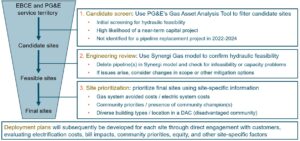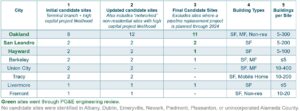Preliminary Results: Identifying Gas Decommissioning Pilot Sites
Introduction
This blog post provides an overview of preliminary results from applying the gas decommissioning site selection framework developed for the Northern California portion of the California Energy Commission’s (CEC) Tactical Gas Decommissioning Project. Two prior blog posts provide an introduction to the project (here) and a description of the proposed site selection framework (here).
Site Selection Framework
The following image describes the proposed site selection framework. This image appears in the second blog post, in which the selection framework is described in greater detail. This post provides an overview of the results from applying this framework to communities in PG&E and EBCE’s shared service territory.
Figure 1. Draft Framework for Identifying Potential Gas Decommissioning Projects

Project Goal: Reflect Diversity of Building Types and Project Communities
A key goal of this project is learning what challenges may exist for decommissioning projects in different building types and in different communities, and considering how community engagement, funding, and other options can address these challenges. To support this learning objective, the project team aims to select a set of pilot sites that reflects some level of diversity in building stock as well as in project communities. Although it is not possible to capture all building types in just three pilots, we intend for our pilots to include single-family residential, multifamily residential, and non-residential buildings. In addition, at least one of the three pilots will be in a Disadvantaged Community (DAC).
Preliminary Results of Step 1 (“Candidate Screen”)
This section describes the application of Step 1 of the selection framework (“Candidate Screen”). More details on the selection framework are provided in our prior blog post.
In applying the candidate screen, the project team first filtered sites using an initial screen for hydraulic feasibility and a screen for high likelihood of a near-term capital project, resulting in the “Initial Candidate Sites” shown in Column 1 of the table below. Using these criteria, no non-residential sites emerged as potential candidates. This finding was inconsistent with the project team’s goal of evaluating a diverse mix of buildings for potential gas decommissioning pilots, including some sites with non-residential buildings. To address this conflict, the project team relaxed the screening for hydraulic feasibility from only considering “terminal branches” to also include “networked” segments of the system with non-residential buildings. You can read more on terminal branches and networked segments in our prior blog post. This adjustment resulted in the “Updated Candidate Sites” shown in the Column 2. Finally, sites with a planned pipeline replacement project in the next few years were excluded, resulting in the “Final Candidate Sites” shown in Column 3.

After application of the candidate screen to communities in EBCE and PG&E’s shared service territory, 14 candidate sites in Oakland, San Leandro, and Hayward emerged as suitable for further consideration (Column 3). The list of eligible sites is relatively small, constrained by the overlap between hydraulic feasibility, likelihood of near-term infrastructure replacement, and a lack of near-term planned pipeline replacement projects. The team also hesitated to advance sites with fewer than 5 buildings to ensure that the pilot projects advance new gas decommissioning learnings. As mentioned in the previous blog post, the majority of PG&E’s historical decommissioning projects have been under 5 buildings. Focusing on projects with more buildings will allow the team to identify pilots that may be more representative of future, larger-scale decommissioning projects.
In addition to diversity of building types, our project’s Technical Advisory Committee (TAC) encouraged consideration of geographic and climate diversity in site selection. This recommendation stems from the possibility that the cost-effectiveness of building electrification may look very different in hot climates with high air conditioning demand. Communities outside of the Bay Area may also require different community engagement strategies. Tracy is the one municipality in PG&E and EBCE’s shared service territory that is located outside of the Bay Area. However, the two sites initially identified in Tracy both have gas pipeline replacements planned in the near term. The project team followed up with PG&E to discuss the likelihood of delays for the proposed projects or the potential to defer the projects to allow time for development of gas decommissioning pilots. However, PG&E informed the project team that the identified projects in Tracy are likely to move forward as planned due to safety and reliability needs. For this reason, no gas decommissioning opportunities in Tracy made it through the first screening step.
Preliminary Results of Step 2 (“Gas Engineering Review”)
 The table above shows the results of PG&E’s engineering review conducted for the 14 final candidate sites in Oakland, San Leandro, and Hayward. 11 out of the 14 sites were deemed viable with either no change to scope or minor changes in scope (i.e., adding or removing small amounts of gas main from the proposed decommissioning project).
The table above shows the results of PG&E’s engineering review conducted for the 14 final candidate sites in Oakland, San Leandro, and Hayward. 11 out of the 14 sites were deemed viable with either no change to scope or minor changes in scope (i.e., adding or removing small amounts of gas main from the proposed decommissioning project).
Three sites, all located in Oakland, were not recommended for gas decommissioning, each for a different reason:
- One site would require expanding the decommissioning project’s scope to avoid stranding some gas customers without gas service. This would entail electrifying more customers and decommissioning significant additional pipeline. However, this additional pipeline has a low likelihood of near-term replacement, making the site much less appealing in terms of overall potential for cost savings. For this reason, the site is not recommended.
- A second site was found to result in capacity shortfalls in the Synergi model. PG&E gas engineers determined that a significant amount of new distribution pipeline would be needed to meet capacity needs in the surrounding areas. Adding a significant amount of new pipe, with corresponding costs, runs counter to the goals of targeted gas decommissioning. For this reason, this site is not recommended.
- A third site was determined to be on a 16-inch diameter gas distribution “rib.” These ribs are the largest gas mains in the distribution system and support gas reliability across a broad geographic region. PG&E does not recommend decommissioning this distribution rib, as it may lead to reliability challenges. Even if Synergi does not show any capacity shortfalls resulting from removing the rib, the system would become much more reliant on a network of nearby smaller pipeline segments. This could result in reliability challenges in the future and may also make it difficult to decommission surrounding pipeline segments in future projects. As the ribs represent a small share of distribution pipeline miles, PG&E’s recommendation is to leave the ribs in place and focus decommissioning efforts on other pipeline segments.
Step 3: Pilot Site Prioritization
Application of the gas engineering review left 11 candidate sites for further consideration. The project team is still determining a final methodology to prioritize sites among the 11 candidates, including consideration of whether and how to incorporate: a) costs of implementing the project including behind the meter device costs, costs to retire the gas pipeline, and any necessary electric capacity investments; b) PG&E gas capital costs that may be avoided through gas decommissioning; c) community priorities and the presence of a community champion; d) the research objective of selecting pilots with diverse building types; and e) the research objective that at least one pilot be located in a disadvantaged community.
If the regulatory and financial challenges around targeted electrification can be overcome in the future, it is possible that PG&E would pursue gas decommissioning for all viable candidate sites. If site prioritization remains necessary due to timing, funding, and/or staffing limitations, the appropriate approach may vary based on the projects and challenges at hand. In addition, site prioritization will evolve as the policy and regulatory context for gas decommissioning changes over time.
Next Steps
The next two blog posts will describe lessons learned to date and progress on community engagement. We also plan to host a public workshop in the fall to hear more from local communities about how best to develop our eventual pilot deployment plans.



